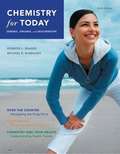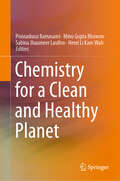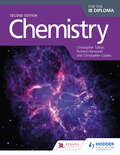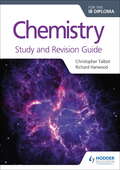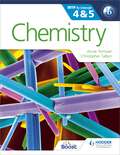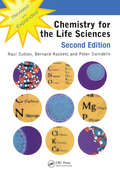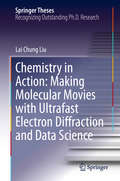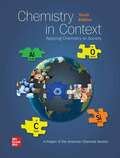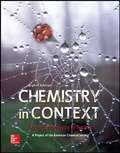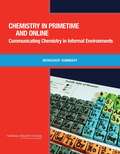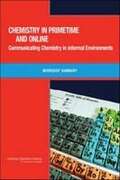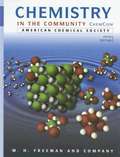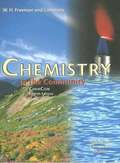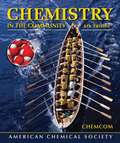- Table View
- List View
Chemistry for Today: General, Organic, and Biochemistry
by Spencer L. Seager Michael R. SlabaughYou will quickly gain a comprehensive understanding of chemistry with this new Sixth Edition of CHEMISTRY FOR TODAY: GENERAL, ORGANIC, AND BIOCHEMISTRY. Using real-life applications and interactive technology tools, this text will show you how chemistry relates to health science. The thorough integration of online assessment and learning tools turns study time into experiences with chemistry--helping you gain true comprehension of chemical concepts. CHEMISTRY FOR TODAY will help dispel any fear you may have of chemistry as it helps you appreciate the role chemistry plays in our daily lives through a rich pedagogical structure and an accessible writing style with lucid explanations. In addition, Seager and Slabaugh's CHEMISTRY FOR TODAY provides greater support in both the problem-solving and critical-thinking skills needed to succeed in chemistry. By illustrating how this information will help your future career and providing important career information online, the authors help you set goals and focus on achieving them.
Chemistry for a Clean and Healthy Planet
by Henri Li Kam Wah Ponnadurai Ramasami Minu Gupta Bhowon Sabina Jhaumeer LaullooThese proceedings gather carefully selected, peer-reviewed contributions from the International Conference on Pure and Applied Chemistry (ICPAC 2018). The event, the latest installment in a biennial conference series, was held in July 2018 in Mauritius.The respective chapters in this unique collection reflect a wide range of fundamental and applied research in the chemical sciences and various interdisciplinary subjects. In addition to reviews, they highlight cutting-edge advances.
Chemistry for the IB Diploma Second Edition
by Christopher Coates Christopher Talbot Richard HarwoodProvide clear guidance to the 2014 changes and ensure in-depth study with accessible content, directly mapped to the new syllabus and approach to learningThis second edition of the highly-regarded first edition contains all SL and HL content, which is clearly identified throughout. Options are available free online, along with appendices and data and statistics.- Improve exam performance, with exam-style questions, including from past papers- Integrate Theory of Knowledge into your lessons and provide opportunities for cross-curriculum study- Stretch more able students with extension activities- The shift to concept-based approach to learning , Nature of Science, is covered by providing a framework for the course with points for discussion - Key skills and experiments included - Full digital package - offered in a variety of formats so that you can deliver the course just how you like!
Chemistry for the IB Diploma Second Edition
by Christopher Coates Christopher Talbot Richard HarwoodProvide clear guidance to the 2014 changes and ensure in-depth study with accessible content, directly mapped to the new syllabus and approach to learningThis second edition of the highly-regarded first edition contains all SL and HL content, which is clearly identified throughout. Options are available free online, along with appendices and data and statistics.- Improve exam performance, with exam-style questions, including from past papers- Integrate Theory of Knowledge into your lessons and provide opportunities for cross-curriculum study- Stretch more able students with extension activities- The shift to concept-based approach to learning , Nature of Science, is covered by providing a framework for the course with points for discussion - Key skills and experiments included - Full digital package - offered in a variety of formats so that you can deliver the course just how you like!
Chemistry for the IB Diploma Study and Revision Guide
by Christopher Talbot Richard HarwoodStretch your students to achieve their best grade with these year round course companions; providing clear and concise explanations of all syllabus requirements and topics, and practice questions to support and strengthen learning. - Consolidate revision and support learning with a range of exam practice questions and concise and accessible revision notes- Practise exam technique with tips and trusted guidance from examiners on how to tackle questions- Focus revision with key terms and definitions listed for each topic/sub topic
Chemistry for the IB Diploma Study and Revision Guide
by Christopher Talbot Richard HarwoodExam Board: IBLevel: IBSubject: ChemistryFirst Teaching: September 2014First Exam: Summer 2016Stretch your students to achieve their best grade with these year round course companions; providing clear and concise explanations of all syllabus requirements and topics, and practice questions to support and strengthen learning. - Consolidate revision and support learning with a range of exam practice questions and concise and accessible revision notes- Practise exam technique with tips and trusted guidance from examiners on how to tackle questions- Focus revision with key terms and definitions listed for each topic/sub topic
Chemistry for the IB Diploma Third edition
by Christopher Talbot Chris DavisonDeveloped in cooperation with the International Baccalaureate®Trust experienced and best-selling authors to navigate the new syllabuses confidently with these coursebooks that implement inquiry-based and conceptually-focused teaching and learning.- Ensure a continuum approach to concept-based learning through active student inquiry; our authors are not only IB Diploma experienced teachers but are also experienced in teaching the IB MYP and have collaborated on our popular MYP by Concept series. - Build the skills and techniques covered in the Tools (Experimental techniques, Technology and Mathematics) with direct links to the relevant parts of the syllabus; these skills also provide the foundation for practical work and internal assessment.- Integrate Theory of Knowledge into your lessons with TOK boxes and Inquiries that provide real-world examples, case studies and questions. The TOK links are written by the author of our bestselling TOK coursebook, John Sprague and Paul Morris, our MYP by Concept series and Physics co-author.- Develop approaches to learning with ATL skills identified and developed with a range of engaging activities with real-world applications. - Explore ethical debates and how scientists work in the 21st century with Nature of Science boxes throughout. - Help build international mindedness by exploring how the exchange of information and ideas across national boundaries has been essential to the progress of science and illustrates the international aspects of science. - Consolidate skills and improve exam performance with short and simple knowledge-checking questions, exam-style questions, and hints to help avoid common mistakes.
Chemistry for the IB Diploma Third edition
by Christopher Talbot Chris DavisonDeveloped in cooperation with the International Baccalaureate®Trust experienced and best-selling authors to navigate the new syllabuses confidently with these coursebooks that implement inquiry-based and conceptually-focused teaching and learning.- Ensure a continuum approach to concept-based learning through active student inquiry; our authors are not only IB Diploma experienced teachers but are also experienced in teaching the IB MYP and have collaborated on our popular MYP by Concept series. - Build the skills and techniques covered in the Tools (Experimental techniques, Technology and Mathematics) with direct links to the relevant parts of the syllabus; these skills also provide the foundation for practical work and internal assessment.- Integrate Theory of Knowledge into your lessons with TOK boxes and Inquiries that provide real-world examples, case studies and questions. The TOK links are written by the author of our bestselling TOK coursebook, John Sprague and Paul Morris, our MYP by Concept series and Physics co-author.- Develop approaches to learning with ATL skills identified and developed with a range of engaging activities with real-world applications. - Explore ethical debates and how scientists work in the 21st century with Nature of Science boxes throughout. - Help build international mindedness by exploring how the exchange of information and ideas across national boundaries has been essential to the progress of science and illustrates the international aspects of science. - Consolidate skills and improve exam performance with short and simple knowledge-checking questions, exam-style questions, and hints to help avoid common mistakes.
Chemistry for the IB MYP 4 & 5: By Concept (MYP By Concept)
by Christopher Talbot Annie TermaatThe only series for MYP 4 and 5 developed in cooperation with the International Baccalaureate (IB)Develop your skills to become an inquiring learner; ensure you navigate the MYP framework with confidence using a concept-driven and assessment-focused approach presented in global contexts.- Develop conceptual understanding with key MYP concepts and related concepts at the heart of each chapter.- Learn by asking questions with a statement of inquiry in each chapter. - Prepare for every aspect of assessment using support and tasks designed by experienced educators.- Understand how to extend your learning through research projects and interdisciplinary opportunities.This title is also available in two digital formats via Dynamic Learning. Find out more by clicking on the links at the top of the page.
Chemistry for the IB MYP 4 & 5: By Concept (MYP By Concept)
by Christopher Talbot Annie TermaatThe only series for MYP 4 and 5 developed in cooperation with the International Baccalaureate (IB)Develop your skills to become an inquiring learner; ensure you navigate the MYP framework with confidence using a concept-driven and assessment-focused approach presented in global contexts.- Develop conceptual understanding with key MYP concepts and related concepts at the heart of each chapter.- Learn by asking questions with a statement of inquiry in each chapter. - Prepare for every aspect of assessment using support and tasks designed by experienced educators.- Understand how to extend your learning through research projects and interdisciplinary opportunities.This title is also available in two digital formats via Dynamic Learning. Find out more by clicking on the links at the top of the page.
Chemistry for the Life Sciences (Lifelines Series)
by Raul SuttonPresents short topics tied to numerical or conceptual ideas, reinforced with worked examples and questions Retaining the user-friendly style of the first edition, this text is designed to eliminate the knowledge gap for those life sciences students who have not studied chemistry at an advanced level. It contains new chapters on -
Chemistry in 17th-Century New England (SpringerBriefs in Molecular Science)
by Gary PattersonThis book explores the lively chemistry culture that arose during the 17th century in Colonial New England. This was chiefly due to the efforts of John Winthrop, Jr. who brought both chemical knowledge and the largest library of chemical books in the New World to Boston. He founded towns, such as Ipswich and New London, and industrial enterprises, such as salt works and ironworks, while also serving as the primary source of Paracelsian medicines, which led him to become the most famous physician in Colonial New England. Moreover, the book covers topics such as the founding of Harvard College, and the life and works of Cotton Mather, especially Magnalia Christi Americana, one of the most important vanity volumes in the history of scholarly publication.
Chemistry in Action: Making Molecular Movies with Ultrafast Electron Diffraction and Data Science (Springer Theses)
by Lai Chung LiuThe thesis provides the necessary experimental and analytical tools to unambiguously observe the atomically resolved chemical reactions. A great challenge of modern science has been to directly observe atomic motions during structural transitions, and while this was first achieved through a major advance in electron source brightness, the information content was still limited and new methods for image reconstruction using femtosecond electron diffraction methods were needed. One particular challenge lay in reconciling the innumerable possible nuclear configurations with the observation of chemical reaction mechanisms that reproducibly give the same kind of chemistry for large classes of molecules. The author shows that there is a simple solution that occurs during barrier crossing in which the highly anharmonic potential at that point in nuclear rearrangements couples high- and low-frequency vibrational modes to give highly localized nuclear motions, reducing hundreds of potential degrees of freedom to just a few key modes. Specific examples are given in this thesis, including two photoinduced phase transitions in an organic system, a ring closure reaction, and two direct observations of nuclear reorganization driven by spin transitions. The emerging field of structural dynamics promises to change the way we think about the physics of chemistry and this thesis provides tools to make it happen.
Chemistry in Context: Applying Chemistry to Society
by Bradley D. Fahlman American Chemical Society Staff Kathleen Purvis-Roberts John S. Kirk Resa M. Kelly Patrick L. DaubenmireFollowing in the tradition of the first nine editions, the goal of this successful, issues-based textbook, Chemistry in Context, is to establish chemical principles on a need-to-know basis for non-science majors, enabling them to learn chemistry in the context of their own lives and significant issues facing science and the world. <p><p>The non-traditional approach of Chemistry in Context reflects today's technological issues and the chemistry principles within them. Global warming, alternate fuels, nutrition, and genetic engineering are examples of issues that are covered in Chemistry in Context.
Chemistry in Primetime and Online: Communicating Chemistry in Informal Environments
by The National Academy of SciencesIt is critical that we increase public knowledge and understanding of science and technology issues through formal and informal learning for the United States to maintain its competitive edge in today's global economy. Since most Americans learn about science outside of school, we must take advantage of opportunities to present chemistry content on television, the Internet, in museums, and in other informal educational settings. In May 2010, the National Academies' Chemical Sciences Roundtable held a workshop to examine how the public obtains scientific information informally and to discuss methods that chemists can use to improve and expand efforts to reach a general, nontechnical audience. Workshop participants included chemical practitioners (e. g. , graduate students, postdocs, professors, administrators); experts on informal learning; public and private funding organizations; science writers, bloggers, publishers, and university communications officers; and television and Internet content producers. Chemistry in Primetime and Onlineis a factual summary of what occurred in that workshop. Chemistry in Primetime and Onlineexamines science content, especially chemistry, in various informal educational settings. It explores means of measuring recognition and retention of the information presented in various media formats and settings. Although the report does not provide any conclusions or recommendations about needs and future directions, it does discuss the need for chemists to connect more with professional writers, artists, or videographers, who know how to communicate with and interest general audiences. It also emphasizes the importance of formal education in setting the stage for informal interactions with chemistry and chemists.
Chemistry in Primetime and Online: Communicating Chemistry in Informal Environments
by Tina MasciangioliIt is critical that we increase public knowledge and understanding of science and technology issues through formal and informal learning for the United States to maintain its competitive edge in today's global economy. Since most Americans learn about science outside of school, we must take advantage of opportunities to present chemistry content on television, the Internet, in museums, and in other informal educational settings. In May 2010, the National Academies' Chemical Sciences Roundtable held a workshop to examine how the public obtains scientific information informally and to discuss methods that chemists can use to improve and expand efforts to reach a general, nontechnical audience. Workshop participants included chemical practitioners (e. g. , graduate students, postdocs, professors, administrators); experts on informal learning; public and private funding organizations; science writers, bloggers, publishers, and university communications officers; and television and Internet content producers. Chemistry in Primetime and Online is a factual summary of what occurred in that workshop. Chemistry in Primetime and Online examines science content, especially chemistry, in various informal educational settings. It explores means of measuring recognition and retention of the information presented in various media formats and settings. Although the report does not provide any conclusions or recommendations about needs and future directions, it does discuss the need for chemists to connect more with professional writers, artists, or videographers, who know how to communicate with and interest general audiences. It also emphasizes the importance of formal education in setting the stage for informal interactions with chemistry and chemists.
Chemistry in Space: From Interstellar Matter to the Origin of Life
by Dieter RehderThe dynamic field of extraterrestrial chemistry brings together ideas of chemistr, astrophysics, and biology to the study of molecules between stars, around stars, and on plantes. This book serves as an introduction to chemial processes under ?unearthly? and hence usually extreme conditions (temperature, pressure, high or low density, bombardment by cosmic rays), and their impact on the early development of our solar system, as well as providing a deeper understanding of processes in earthly regions where conditions approach those of extraterrestrial areas. A unique and extraordinary perspective written with chemists in mind. An excellent practical book for inorganic, and physical chemists, spectroscopists, astronomers, and libraries. From the contents: * Introduction and technical notes * Origin and development of the universe * Stars * The interstellar medium * The solar system * Exoplanets * The origin of life
Chemistry in The Earth System: Integrating Chemistry and Earth Science, NGSS
by Tracey Greenwood Kent Pryor Lissa Bainbridge-SmithNIMAC-sourced textbook
Chemistry in the Community
by American Chemical Society"Chemistry in the Community is a post-secondary chemistry course structured around applied community issues related to chemistry rather than around specific chemical concepts. Concepts are presented on a ""need-to-know"" basis, allowing students to experience chemistry on first hand. The course is about 50% laboratory-based, and features activities where students must apply their chemistry knowledge to realistic decision-making situations."
Chemistry in the Community
by American Chemical Society"Chemistry in the Community is a post-secondary chemistry course structured around applied community issues related to chemistry rather than around specific chemical concepts. Concepts are presented on a ""need-to-know"" basis, allowing students to experience chemistry on first hand. The course is about 50% laboratory-based, and features activities where students must apply their chemistry knowledge to realistic decision-making situations."
Chemistry in the Community (4th Edition)
by American Chemical SocietyChemistry in the Community (ChemCom) is a year-long high school chemistry course for college-bound students, structured around community issues related to chemistry. The course is about 50% laboratory-based, and features decision-making activities which give students practice in applying their chemistry knowledge in realistic decision-making situations. Concepts are presented on a "need-to-know" basis, allowing students to experience the use and application of their chemistry learning, leading to a greater sense of motivation and a feeling of ownership of their new knowledge. Because of the nature of the issues covered in the specific units, students learn more organic and biochemistry than in traditional courses, as well as some environmental and industrial chemistry.
Chemistry in the Community (ChemCom), Sixth Edition
by American Chemical SocietyThe book offers a meaningful and memorable chemistry program for all levels of high school students and covers traditional chemistry topics within the context of societal issues and real-world scenarios. Centered on decision-making activities where students are responsible for generating data in an investigating, analyzing that data and then applying their chemistry knowledge to solve the presented problem.
Chemistry in the Community: Chemcom
by American Chemistry SocietyNIMAC-sourced textbook <P><P>Touted as the most successful NSF-funded project published, Chemistry in the Community (ChemCom) by the American Chemical Society (ACS) offers a meaningful and memorable chemistry program for all levels of high school students. ChemCom covers traditional chemistry topics within the context of societal issues and real-world scenarios. Centered on decision-making activities where students are responsible for generating data in an investigating, analyzing that data and then applying their chemistry knowledge to solve the presented problem. The text is intensively laboratory-based, with all 39 of the investigations integrated within the text, not separate from the reading. With the ChemCom program, students learn more organic and biochemistry, more environmental and industrial chemistry, and more on the particulate nature of matter than other textbooks all within the relevance of solving problems that arise in everyday life. <P><P>Meticulously updated to meet the needs of today's teachers and students, the new sixth edition of ChemCom adheres to the new science framework as well as the forthcoming next generation of science standards. Incorporating advances in learning and cognitive sciences, ChemCom’s wide-ranging coverage builds upon the concepts and principles found in the National Science Education Standards. Correlations are available showing how closely aligned ChemCom is to these and other state standards
Chemistry in the Earth System
by Tracey Greenwood Richard Allan Kent Pryor Lissa BainbridgeChemistry in the Earth System has been designed and written following the High School Three-Course Model for California. It will also suit NGSS-aligned states integrating Earth Science with Chemistry. This phenomena-based title takes a three-dimensional approach to provide an engaging, relevant, and rigorous program of instruction. Departing from the more traditional approach of BIOZONE’s Non-Integrated Series, the Integrated Series offers a learning experience based on the 5 Es and anchored in student-relevant phenomena and problems. Contents Combustion and Energy Transfer Heat and Energy in the Earth System Atoms, Elements, and Molecules Chemical Reactions Chemistry of Climate Change The Dynamics of Chemical Reactions & Ocean Acidification Basic skills for chemistry students
